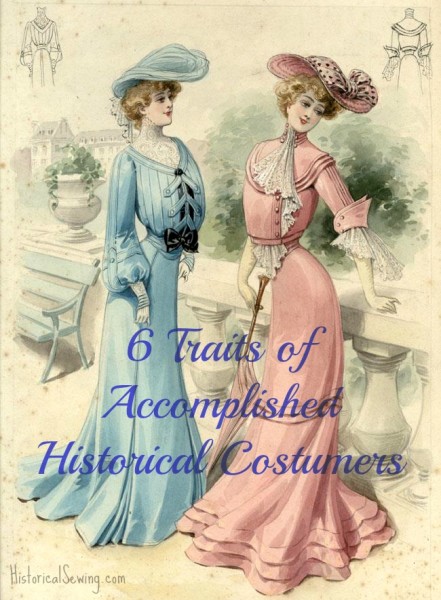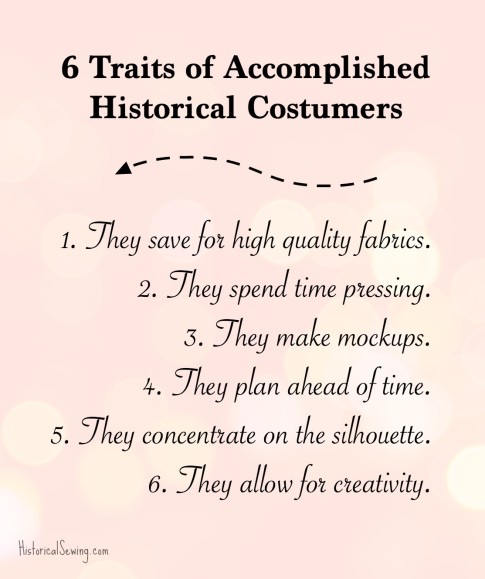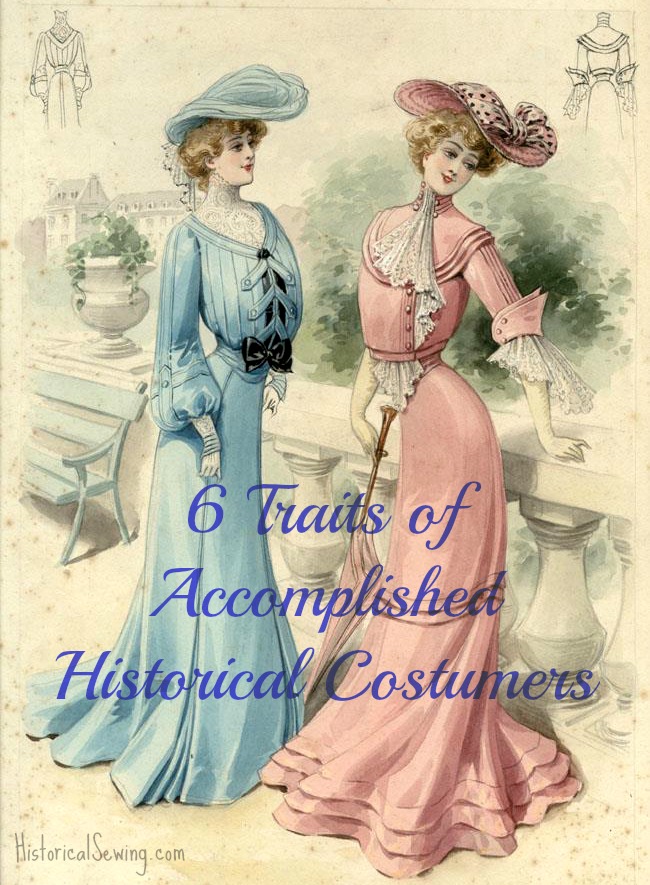
We all have those few REALLY good costumers who we look up to and admire. Your list of names may be similar to mine but both contain brilliant, creative people who astound and inspire us. We want to be them when we grow up!
No matter the simplicity or detail produced by your sewing heroes, I’ve found a few habits that run in those costumers that make period clothing construction look SOOO easy. Not every successful costumer may follow these traits every project. (Sometimes the dress just needs to get done NOW!) But if you study their work you’ll begin to see a connection with these six habits and the outcome of the finished ensemble.
Perhaps this list will trigger you to bump up your own creative game so you can inspire someone else (and possibly end up on their list). 🙂
These 6 specific characteristics are not in any particular order. Use them as you study other dressmakers & tailors and apply them to your own sewing.

Thriving Historical Costumers We Admire:
1. They save for high quality fabrics.
Truly, materials make a difference. A polyester satin just looks out of place in a period garment. Rarely will you see one of our fine costumers use a synthetic textile. That’s what makes their costumes so wonderful looking! When we see an ensemble that’s magnificent, more often than not, it’s made from natural fibers (cotton, linen, wool or silk) and there’s a good portion of that material too. They don’t skimp!
Fabric selection is one of the biggest mistakes costumers make. Accomplished crafters know their materials and save their pennies for the Good Stuff.
I used to think silk was expensive, out of my budget. Then I happened to find some reasonable stuff, and man! I haven’t looked back because the quality of that dress was so much better than I had made before. Yes, silk and wool can be pricey but SOOO worth delaying your project a couple months to save up.
2. They spend time pressing seams and fabrics and trims.
Yes, a good amount of what makes a costumer stand out from the rest is amazing construction of the garment pieces. But… pressing takes your sewing to the next level.
Skipping the pressing that naturally dovetails with sewing can produce a “happy hands at home” look. Ack! Our Fabulous Costumers don’t look like that and we don’t want to either. Pressing can take a mediocre costume to outstanding period clothing.
The small tasks of pressing seams flat then open and steam pressing purchased trim to pop up the appearance may seem boring. However, it’s these little sewing details that make us admire and wonder at the finished look. Guaranteed – ironing & pressing is what our accomplished costumers do. Let’s follow their lead and press fabrics before & during construction and treat every seam as it happens.
3. They make mockups.
Ok. Before you say “duh” – think about it. Successful costumers look *fabulous*, right? That dress or coat looks like it was made for them. Well, it’s because it was! That remarkable fit means they took time to fit. Because nobody looks that good with a pattern made straight “out of the box.” It just doesn’t happen.
But they don’t do that custom fitting on expensive silk taffeta either. They spend time tweaking a pattern or a drape in inexpensive fabric until it’s the best result they can produce. Sometimes this may mean a couple of mockups. Only then do they cut into the nice fabric.
They also don’t reinvent the wheel. If they’ve made a bustle dress in the past then they’ll consider patterns and specific sewing techniques used before to apply to the new piece of work. The research done for past projects provides the foundation for the new one. No need to start from scratch!
They build on what worked before. And the more mockups you make, the better you know your own figure and the fitting tweaks you’ll need to do with every garment, which in turn produces better results.
4. They plan ahead of time.
Success doesn’t happen overnight – this includes sewing.
The accomplished costumers we follow know this. It can take weeks or months (and sometimes years!) to produce an ensemble worthy of drool. They know that it takes time to find the right fabric. The perfect trim could be elusive and hide for months until one day it pops out at you. Life happens and we have to work our creativity around other occurrences.
Successful costumers know that good things are worth waiting for.
Talent and skill take time to build up. They’ve paid their dues on too many overnighters to count so the dress would be wearable at the ball the next evening. They know that if they had started just a wee bit sooner the outfit would have been even better. So those spectacular ensembles we admire started as a simple idea many months before.
That’s not to say they can’t make something fabulous happen the week before the event (see #6). They just know that the more time for a project idea to stew in the mind the better the outcome, the finer the fit on the mockups, and the better quality of materials to be used because they took significant time to search for them.
5. They concentrate on the silhouette.
For a costume to be believable, to look like the modern person stepped out of the past, the well-executed silhouette must be present. Talented period costumers know this. They build from the skin out – from chemise to bonnet – creating the desired look of the past.
A 1880s dress doesn’t look right if the correct wired or padded shape is missing. Sleeve puffs, a la Anne Shirley, fall flat if not supported from the inside. And a 1830s skirt wrapping around the legs just doesn’t give off that “feel” of the Romantic Era.
Great costumers are quite aware of this, and so spend their time building appropriate undergarments first before creating the outer garments to wear on top (see #4 if you didn’t get the point the first time).
A side effect of spending so much time on creating the silhouette – you generally only need to make all those layers once and replace as necessary. Once made, you can go about making loads of garments for that time period. That’s when costuming really gets fun! So Sew-All-The-Petticoats! And create your own believable period costume that inspires someone else. 🙂
6. They allow time for creativity.
This “time” could be a few hours in which textiles fly about the room, or a year before the event in which they study a new technique required for what they want to accomplish (cartridge pleats, anyone?).
Brilliant costumers will let a fabric or trim “speak” to what it wants and where it wants to go. Sometimes the purple roses are just not working so they make time to run to the store and get pink hydrangeas instead. When those don’t work they grab the white tulle…. all in an afternoon.
Some of the best creative thoughts come as you simply start playing. Ask those gifted costumers we follow and many will tell you of the “accident” that became brilliance in the final outfit. They listened to their heart and followed the creative eye.
Historical costuming is a delightful art. And, as with all art, inspiration ebbs and flows. We must allow ourselves to be open to it.
Use this list of 6 traits as you approach your upcoming costuming projects. Keep in mind, also, those costumers on your list who most likely follow these traits – from corset extraordinaire to a master crafter of trim. Together they light that historical costuming passion within us to push us to be more. 🙂
Have you found a specific characteristic in a costuming or sewing “celebrity” you follow that has inspired your own creativity? Such as using historical techniques or bravery in their crafting?


I thoroughly enjoyed your blog. Lol quite a bit especially the description of how creativity flies together sometimes and how it does not at other times. Trim has often leapt off the shelf at me too. I have only done one historic costume and I just wasn’t getting the 1920s silhouette until I took my bra off!! Then voila!!
I think this list applies to creative 3-D artists everywhere, whatever their discipline. Over the past forty years I’ve earned my living making jewellery, ceramics, textile hangings, miniature embroidery, millinery and hand-painted silks, (not all at the same time.) Whatever, one needs quality from start to finish: quality of materials, of technique, of tools and that ultimate luxury, the time to respond to the medium and see what it is doing. Never mind ‘mastering’ the fabric, let it speak, get a dialogue going, ‘See’ in your mind what you are aiming for but be open to the changes the materials suggest.
I love your work and your dedication; I salute you.
They do lots of hand sewing! So many details just work best done by hand.
I’m still a big fan of cottons as I like more variety of designs on my fabrics than are available in silks.
I’m still learning how to deal with my fitting problems (short sloped shoulders/short waist) but seems to improve in baby steps.
My focus the last couple years has been studying the accessories worn with the dresses so they look like *real* clothes. And doing more trimming when it fits the situation.
Val
Accessories are so important. I keep working to make mine better.
* Avoid anachronisms as much as possible to help a dress make that leap from costume to clothing. Hide your watch. Sew a hidden pocket for your cel phone. Put on an extra petticoat.
* Don’t forget necessities like hats and gloves. Nothing destroys a movie faster in my estimation than to see the characters running around hatless and lacking the basic accessories of the period. No respectable 19th (or earlier) Century woman would leave the house bare-headed.
I agree completely with your list but would just expand item #1 to include quality trims as well. I have seen some lovely natural fiber dresses trimmed with synthetic lace which brought the overall look down a notch from what it could have been.
* They pick colours, textures, trims and silhouettes that suit their body and their personality (and/or their historical persona, if they are re-enactors; or their character, if they are cosplayers or actors).
* they practice for years, building their skills gradually and not letting a few failures put them off.
*they practice wearing the clothes once they’ve made them, to get used to the way they feel and the way they encourage them to move.
Great additions to the list Holly!